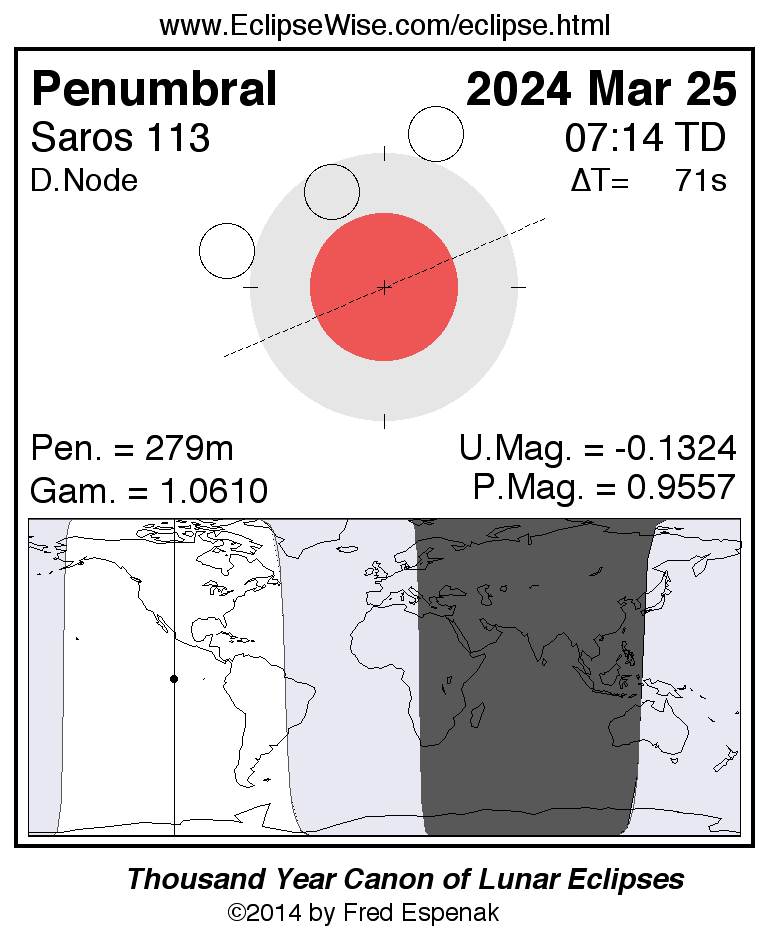Prepare for an awe-inspiring celestial event on the night of March 25, 2024. The Earth will position itself between the Sun and the Moon, casting a shadow on our lunar companion and causing it to appear dimmer.
This event coincides with the Festival of Colours, a vibrant Hindu festival that heralds the arrival of spring and symbolizes fresh starts. For locations that are six hours or more behind GMT (west of Chicago), the eclipse will commence on the previous night, March 24, 2024.
But where can you witness this lunar eclipse? What distinguishes a penumbral from an umbral eclipse? Will the Moon adopt a red hue? And which constellation will the Moon inhabit during the eclipse? Find the answers to these questions and more below.
When will the lunar eclipse take place?
The penumbral lunar eclipse is slated for March 24-25, 2024.
For UK observers, the eclipse will transpire in the hours preceding sunrise, with the Moon dipping below the horizon at its maximum extent. In Bristol, the Sun will rise at 6am GMT on March 25, meaning the eclipse will occur in the early dawn sky, just prior to moonset.
The eclipse will reach its greatest magnitude at 6:03am GMT, while the entire Moon is still visible above the horizon. The true maximum, at 7:12am, won’t be observable because the Moon will have descended below the horizon by then.
At 6:11am GMT, the Moon will start to set. However, the combination of a low-hanging Moon and the maximum eclipse phase will cause the Moon to dim before it sets, potentially causing it to vanish from sight.
US eclipse watchers will have a better vantage point for the eclipse, as the Moon will remain above the horizon for the duration of the lunar eclipse.
Eclipse Timings:
For Bristol, UK:
- Penumbral eclipse begins: March 25, 4:53am GMT (visible, Moon above the horizon)
- Maximum eclipse: March 25, 7:12am GMT (Moon below the horizon)
- Penumbral eclipse ends: March 25, 9:32am GMT (Moon below the horizon)
For New York City, US:
- Penumbral eclipse begins: March 25, 00:53am EST (visible, Moon above the horizon)
- Maximum eclipse: March 25, 3:12am EST (visible, Moon above the horizon)
- Penumbral eclipse ends: March 25, 5:32am EST (visible, Moon low on the horizon)
For San Francisco, US:
- Penumbral eclipse begins: March 24, 9:53pm PST (visible, Moon above the horizon)
- Maximum eclipse: March 25, 00:12am PST (visible, Moon above the horizon)
- Penumbral eclipse ends: March 25, 2:32am PST (visible, Moon above the horizon)
Note: In the US, the clocks were adjusted to daylight-saving time on March 10. In the UK, the clocks will switch to BST on March 31.
Where will the lunar eclipse be visible?
The lunar eclipse on March 25 will be visible across the entirety of the US, South America, and Canada, the UK, much of Europe, much of Africa, North and East Asia, western Australia, the Arctic, and Antarctica.
For locations further west than Chicago, Illinois, the eclipse will commence the night before on March 24 and will be visible until sunrise.
What is Penumbral Lunar Eclipse?
A penumbral lunar eclipse occurs when the Moon passes through Earth’s penumbra, the lighter, more diffuse part of the shadow cast by any object in front of a light source. This results in a partial shading of the Moon, which can be somewhat difficult to observe from Earth due to the subtle dimming of the Moon’s brightness.

During a full lunar eclipse, the Moon moves into Earth’s darker central shadow, the umbra, resulting in more dramatic changes in its appearance. Depending on the Moon’s position in Earth’s shadow, it can take on a range of colors from light red to blood-red.
Causes of a Lunar Eclipse
A lunar eclipse occurs when the Earth moves between the Sun and the Moon, casting a shadow on the Moon. The Moon is visible to us because it reflects sunlight, so during a lunar eclipse, this sunlight is blocked from reflecting off the Moon’s surface.
Stages of a Lunar Eclipse
During a total lunar eclipse, the Moon first passes into Earth’s penumbra, then moves into the darker umbra, before returning to the penumbra on the other side, and finally moving out of the shadow altogether.
Upcoming Lunar Eclipses
Here are the upcoming lunar eclipses:
- 25 March 2024: Penumbral
- 18 September 2024: Partial
- 14 March 2025: Total
- 7 September 2025: Total
- 3 March 2026: Total
- 28 August 2026: Partial
- 20 February 2027: Penumbral
- 18 July 2027: Penumbral
- 17 August 2027: Penumbral
- 12 January 2028: Partial
- 6 July 2028: Partial
- 31 December 2028: Total
- 26 June 2029: Total
- 20 December 2029: Total
Viewing Tips for the Lunar Eclipse
Unlike during a solar eclipse, you do not need any special equipment to view a lunar eclipse. There is no risk to your eyes from looking at a full Moon, so it’s quite safe to look at the Moon during a lunar eclipse. This is because the Moon only reflects sunlight – it doesn’t have its own light source – and it doesn’t emit any radiation dangerous to human eyes.
Observing the ‘Rogue Comet’
For those interested in observing the ‘Devil Comet’, the start of the lunar eclipse may offer a slight dimming of the full Moon at the same time the comet is above the horizon. Under dark skies, look towards the west-northwest horizon as darkness falls. The comet is visible now through a telescope or binoculars, but visibility will increase as we approach the end of March. There’s also the tantalizing possibility of it reaching naked-eye visibility towards the end of the month.
Discover more from MUZZLECAREERS
Subscribe to get the latest posts sent to your email.









The synchronicity of the lunar eclipse with the Festival of Holi is indeed intriguing. The festival, which celebrates the arrival of spring and new beginnings, seems to be a fitting backdrop for such a celestial event. It’s as if nature itself is participating in the celebration.
Penumbral eclipses are often overlooked due to their subtlety, but they offer a unique opportunity to observe the intricate interplay of light and shadow in our solar system. It’s a reminder of the delicate balance and immense scale of the cosmos.
The visibility of the eclipse across such a vast swath of the globe is a testament to the universal appeal of these celestial events. Regardless of our location or culture, we all look up at the same sky, a reminder of our shared humanity.
The anticipation of upcoming eclipses adds an element of excitement to the life of every skywatcher. Each event is a chance to learn, observe, and appreciate the celestial mechanics at play.
The safe viewing of lunar eclipses is indeed a boon. It allows everyone, from casual observers to seasoned astronomers, to enjoy the spectacle without the need for specialized equipment.
The potential visibility of Comet C/2023 E3 (ZTF) during the eclipse is an added bonus for skywatchers. It’s opportunities like these that make astronomy such a rewarding hobby.
I’m definitely excited to see them lunar eclipse
This is a great opportunity to introduce my children to the wonders of the cosmos
There’s something nostalgic about watching a lunar eclipse. It’s like a time machine, transporting you back to past eclipses you’ve witnessed. Each one is unique, yet they all share that same sense of awe and wonder.
I remember my first lunar eclipse – I was just a kid, and it felt like I was witnessing a miracle. Now, every time there’s an eclipse, I’m taken back to that moment.
Быстрый ремонт автомобилей для нервных водителей
Автосервис по японским автомобилям [url=https://www.tokyogarage.ru]https://www.tokyogarage.ru[/url].